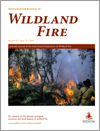International Journal of Wildland Fire
Volume 27
Number 10 2018
Prescribed burning (PB) is widely employed in mediterranean-climate ecosystems in an attempt to reduce wildfires. They are also biodiversity hotspots, however, and the impact of deliberately imposed fire is poorly understood. The experience, over a 50-year period in south-western Western Australia, foreshadows its possible long-term impact in other mediterranean ecosystems.
We used aerial images to locate different-aged burns, undertaken as part of grouse-moor management, within an area of blanket peat. We found that this prescribed burning produced highest levels of cover of peat-building plant species on areas that had been burned within 3–10 years. Longer post-burn periods resulted in increased heather cover and vegetation height.
A quantitative exploration of the structure and relationships between values affected by wildfire and its management provides insights for understanding and incorporating values of the public in strategic wildfire planning.
Complainants expressed health concerns and mentioned that air pollution from letting fires burn was causing many elderly to leave the area and negatively impacted the local tourism economy. This study identified an underlying mistrust in land-management strategies. Complaints were mainly initiated when it was assumed that full suppression was not pursued.
Adding wildland fire emissions to the CMAQ model increases the number of ‘grid-cell days’ with daily fine particulate matter (PM2.5) concentrations above 35 µg m−3 by a factor of 4. Model results suggest the need to better characterise wildland fires.
We classified burn extent, severity, and vegetation recovery for a time series of high-resolution images over the Waldo Canyon fire, Colorado, USA. High-resolution (2 m) imagery is increasingly available and can be used to enhance our ability, relative to coarser resolution sources of imagery, to map fire characteristics and recovery.





